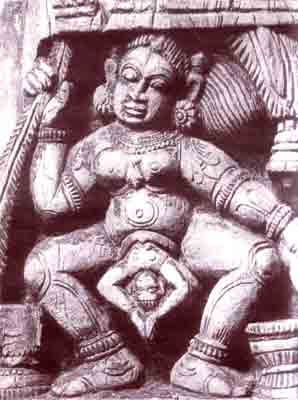Feminine Divinity and a Posture for Birth
The woman who moves into this position in very late labor (“second stage”), when the fetal expulsion reflex is happening, harmonizes great efficiency each time the uterus pulses (each one a concentration of shakti prana). Labor is completed far more easily and quickly and the mother’s whole orientation and appreciation of her role in birth alters if she adopts this posture. The downwards and forwards orientation of the pelvic floor and the birth passage in the squatting position is such that all her efforts are concentrated directly into the center – the infant down, forward and out of her body, without wasting any energy needlessly in other directions. The pelvic outlet is widened an additional centimeter (a very significant amount) and the intra-abdominal space is increased 20-30% allowing for more uterine freedom. In addition the whole process is assisted by the force of gravity. With adequate yogic preparation, a woman can give birth easily from kali asana, requiring only minimal guidance and assistance from the attending midwife or doctor.
In addition to using the image presented here for her visualization purposes, the pregnant woman can also refer to Dr. Saraswati’s comments, which are very helpful in how they describe labor and the birthing process. Words can be quite effective in encouraging a positive visualization of the actual birth, and Dr. Saraswati’s description is powerful. As for the image itself, the relief is presented in a forward-facing fashion, The figure’s eyes are closed as she squats, her legs pressing energy down to the large lips of her vaginal opening, which releases her baby downward. An energy courses through the figure’s body, traveling from her right hand, which pulls on a thick and sturdy tether at her side, down to her baby, whose arms move vertically in a prayer position towards the earth.
Images of actual people engaging in kali asana are also helpful to pregnant women as they try to imagine which of the variety of positions they might choose to birth their babies. I believe that the below images, both taken from lotusfertility.com, are fruitful in representing the birth position of kali asana.
Kali Asana: Yoga Position for Birth
Kali Asana: Supported Yoga Position for Birth
[1] For a detailed description of Kali’s complex role within Hinduism, see David Kinsley’s Hindu Goddesses: Visions of the Divine Feminine in the Hindu Religious Tradition (1998).



unfortunately, the spirit of Kali herself advocates to have a squatting birthing because of the spiritual implications it has. Only the initiated into tantric practices understand this.